Mapping the Integration of Urban Air Mobility into the Built Environment: A Bibliometric Analysis and a Scoping Review
Abstract
1. Introduction
- How can the research landscape be mapped in terms of publications and citations to identify the most influential sources, leading countries, and international collaborations?
- What are the main research themes emerging in this field?
- How is the research on UAM integration evolving, and what are the future directions?
2. Methods
2.1. Search Strategy
- Only English-written papers were included.
- The publication period was restricted to 2010–2024. We selected 2010 as the starting year since it marks the year of reintroduction of on-demand UAM services [19]. We chose 2024 as the end year to avoid data bias, since we are still in the year of 2025 at the time of writing.
- Articles from the following subject areas were excluded to remove unrelated studies: Medicine, Health Professions, Pharmacology, Toxicology and Pharmaceutics were excluded.
2.2. Bibliometric and Scoping Analyses
3. Results
3.1. Publication and Citation Trends
3.2. Document Types and Leading Sources
3.3. Institutions, Countries and International Collaborations
3.4. Thematic Analysis
- Air traffic management (purple cluster)
- Acoustic noise assessment (red cluster)
- Wind effects assessment (green cluster)
- Risk assessment (yellow cluster)
- Vertiports location (blue cluster)
3.4.1. Air Traffic Control
3.4.2. Noise Pollution Due to Aircraft
3.4.3. Wind
3.4.4. Risk Assessment
- Pre-tactical approaches (up to 2 h before), including planning done just before the mission, using updated data to implement safety levels.
- Tactical approaches (during the flight), such as real-time managed re-risk during flight [50].
3.4.5. Ground Infrastructure and Vertiports Placement
4. Discussion
5. Conclusions
- Encouraging the use of risk mapping to compare UAV operation scenarios, which can be useful to identify high-exposure areas or potential hazards based on different perspectives. The visualization of risk could help planners to evaluate and compare different UAM implementation strategies, considering the risk mitigation for both citizens and urban infrastructure.
- Creating comprehensive urban spatial databases containing detailed information about urban features (morphology, infrastructure, and risk zones), which could be a reliable basis to perform accurate simulations, improving the planners’ awareness of the existing urban environment.
- Developing urban digital twins to support real-time simulations and planning UAV operations in different scenarios. Indeed, urban digital twins can provide a high-fidelity virtual representation of the city, allowing UAV trajectories to be tested under different boundary conditions, while also predicting the environmental impacts, like wind effect and noise pollution.
- Developing multi-objective optimization frameworks for UAV path planning, incorporating real-time urban and environmental constraints. Such frameworks should include multiple objectives, balancing the minimisation of noise pollution, safety and security, while also considering real-time traffic, weather, and urban conditions.
Supplementary Materials
Author Contributions
Funding
Data Availability Statement
Conflicts of Interest
References
- EASA. What Is UAM. Available online: https://www.easa.europa.eu/en/what-is-uam (accessed on 8 January 2025).
- Garrow, L.A.; German, B.J.; Leonard, C.E. Urban Air Mobility: A Comprehensive Review and Comparative Analysis with Autonomous and Electric Ground Transportation for Informing Future Research. Transp. Res. Part. C Emerg. Technol. 2021, 132, 103377. [Google Scholar] [CrossRef]
- Rezende, R.N.; Barros, E.; Perez, V. General Aviation 2025—A Study for Electric Propulsion. In Proceedings of the 2018 Joint Propulsion Conference, Cincinnati, OH, USA, 9–11 July 2018; American Institute of Aeronautics and Astronautics: Reston, VA, USA, 2018. [Google Scholar]
- Littell, J.D.; Gardner, N.W.; Ellafrits, S.A. Dynamic Testing of EVTOL Energy Storage Systems: Literature Review and Path Forward; National Aeronautics and Space Administration Langley Research Center: Hampton, VA, USA, 2023. [Google Scholar]
- Moore, M. NASA Puffin Electric Tailsitter VTOL Concept. In Proceedings of the 10th AIAA Aviation Technology, Integration, and Operations (ATIO) Conference, Fort Worth, TX, USA, 13–15 September 2010; p. 9345. [Google Scholar]
- Xiang, S.; Xie, A.; Ye, M.; Yan, X.; Han, X.; Niu, H.; Li, Q.; Huang, H. Autonomous EVTOL: A Summary of Researches and Challenges. Green Energy Intell. Transp. 2024, 3, 100140. [Google Scholar] [CrossRef]
- Hu, L.; Yan, X.; Yuan, Y. Development and Challenges of Autonomous Electric Vertical Take-off and Landing Aircraft. Heliyon 2025, 11, e41055. [Google Scholar] [CrossRef]
- Vidović, A.; Štimac, I.; Mihetec, T.; Patrlj, S. Application of Drones in Urban Areas. Transp. Res. Procedia 2024, 81, 84–97. [Google Scholar] [CrossRef]
- KPMG Aviation 2030. Passenger Use Cases in the Advanced Air Mobility Revolution. 2022. Available online: https://assets.kpmg.com/content/dam/kpmg/ie/pdf/2022/07/ie-advanced-air-mobility-revolution.pdf (accessed on 8 January 2025).
- Rothfeld, R.; Fu, M.; Balać, M.; Antoniou, C. Potential Urban Air Mobility Travel Time Savings: An Exploratory Analysis of Munich, Paris, and San Francisco. Sustainability 2021, 13, 2217. [Google Scholar] [CrossRef]
- Yedavalli, P.S.; Onat, E.; Peng, X.; Sengupta, R.; Waddell, P.; Bulusu, V.; Xue, M. Assessing the Value of Urban Air Mobility through Metropolitan-Scale Microsimulation: A Case Study of the San Francisco Bay Area. In Proceedings of the AIAA AVIATION 2021 FORUM, Virtual, 2–6 August 2021; American Institute of Aeronautics and Astronautics: Reston, VA, USA, 2021. [Google Scholar]
- Tojal, M.; Paletti, L. Is Urban Air Mobility Environmentally Feasible? Defining the Guidelines for a Sustainable Implementation of Its Ecosystem. Transp. Res. Procedia 2023, 72, 1747–1754. [Google Scholar] [CrossRef]
- Zhao, P.; Post, J.; Wu, Z.; Du, W.; Zhang, Y. Environmental Impact Analysis of On-Demand Urban Air Mobility: A Case Study of the Tampa Bay Area. Transp. Res. D Transp. Environ. 2022, 110, 103438. [Google Scholar] [CrossRef]
- EASA Drones & EVTOL Designs. Available online: https://www.easa.europa.eu/en/domains/drones-air-mobility/drones-evtol-designs (accessed on 8 January 2025).
- Durán-Delfín, J.E.; García-Beltrán, C.D.; Guerrero-Sánchez, M.E.; Valencia-Palomo, G.; Hernández-González, O. Modeling and Passivity-Based Control for a Convertible Fixed-Wing VTOL. Appl. Math. Comput. 2024, 461, 128298. [Google Scholar] [CrossRef]
- Estevez, J.; Garate, G.; Lopez-Guede, J.M.; Larrea, M. Review of Aerial Transportation of Suspended-Cable Payloads with Quadrotors. Drones 2024, 8, 35. [Google Scholar] [CrossRef]
- Hegde, A.; Ghose, D. Multi-UAV Collaborative Transportation of Payloads With Obstacle Avoidance. IEEE Control Syst. Lett. 2022, 6, 926–931. [Google Scholar] [CrossRef]
- Straubinger, A.; Rothfeld, R.; Shamiyeh, M.; Büchter, K.-D.; Kaiser, J.; Plötner, K.O. An Overview of Current Research and Developments in Urban Air Mobility—Setting the Scene for UAM Introduction. J. Air Transp. Manag. 2020, 87, 101852. [Google Scholar] [CrossRef]
- Cohen, A.P.; Shaheen, S.A.; Farrar, E.M. Urban Air Mobility: History, Ecosystem, Market Potential, and Challenges. IEEE Trans. Intell. Transp. Syst. 2021, 22, 6074–6087. [Google Scholar] [CrossRef]
- Pak, H.; Asmer, L.; Kokus, P.; Schuchardt, B.I.; End, A.; Meller, F.; Schweiger, K.; Torens, C.; Barzantny, C.; Becker, D.; et al. Can Urban Air Mobility Become Reality? Opportunities and Challenges of UAM as Innovative Mode of Transport and DLR Contribution to Ongoing Research. CEAS Aeronaut. J. 2024, 16, 665–695. [Google Scholar] [CrossRef]
- Zewde, L.; Raptis, I.A. Conceptualizing UAM: Technologies and Methods for Safe and Efficient Urban Air Transportation. Green Energy Intell. Transp. 2025; in press. [Google Scholar] [CrossRef]
- Nithya, D.S.; Quaranta, G.; Muscarello, V.; Liang, M. Review of Wind Flow Modelling in Urban Environments to Support the Development of Urban Air Mobility. Drones 2024, 8, 147. [Google Scholar] [CrossRef]
- García-Gutiérrez, A.; Gonzalo, J.; López, D.; Delgado, A. Advances in CFD Modeling of Urban Wind Applied to Aerial Mobility. Fluids 2022, 7, 246. [Google Scholar] [CrossRef]
- Lotinga, M.J.B.; Ramos-Romero, C.; Green, N.; Torija, A.J. Noise from Unconventional Aircraft: A Review of Current Measurement Techniques, Psychoacoustics, Metrics and Regulation. Curr. Pollut. Rep. 2023, 9, 724–745. [Google Scholar] [CrossRef]
- Kapoor, R.; Kloet, N.; Gardi, A.; Mohamed, A.; Sabatini, R. Sound Propagation Modelling for Manned and Unmanned Aircraft Noise Assessment and Mitigation: A Review. Atmosphere 2021, 12, 1424. [Google Scholar] [CrossRef]
- Yang, C.; Wallace, R.J.; Huang, C. A Review and Bibliometric Analysis of Unmanned Aerial System (UAS) Noise Studies Between 2015 and 2024. Acoustics 2024, 6, 997–1020. [Google Scholar] [CrossRef]
- Schuchardt, B.I.; Geister, D.; Lüken, T.; Knabe, F.; Metz, I.C.; Peinecke, N.; Schweiger, K. Air Traffic Management as a Vital Part of Urban Air Mobility—A Review of DLR’s Research Work from 1995 to 2022. Aerospace 2023, 10, 81. [Google Scholar] [CrossRef]
- Mavraj, G.; Eltgen, J.; Fraske, T.; Swaid, M.; Berling, J.; Röntgen, O.; Fu, Y.; Schulz, D. A Systematic Review of Ground-Based Infrastructure for the Innovative Urban Air Mobility. Trans. Aerosp. Res. 2022, 2022, 1–17. [Google Scholar] [CrossRef]
- Brunelli, M.; Ditta, C.C.; Postorino, M.N. New Infrastructures for Urban Air Mobility Systems: A Systematic Review on Vertiport Location and Capacity. J. Air Transp. Manag. 2023, 112, 102460. [Google Scholar] [CrossRef]
- Schweiger, K.; Preis, L. Urban Air Mobility: Systematic Review of Scientific Publications and Regulations for Vertiport Design and Operations. Drones 2022, 6, 179. [Google Scholar] [CrossRef]
- Wild, G. Urban Aviation: The Future Aerospace Transportation System for Intercity and Intracity Mobility. Urban Sci. 2024, 8, 218. [Google Scholar] [CrossRef]
- Pons-Prats, J.; Živojinović, T.; Kuljanin, J. On the Understanding of the Current Status of Urban Air Mobility Development and Its Future Prospects: Commuting in a Flying Vehicle as a New Paradigm. Transp. Res. E Logist. Transp. Rev. 2022, 166, 102868. [Google Scholar] [CrossRef]
- Zupic, I.; Čater, T. Bibliometric Methods in Management and Organization. Organ. Res. Methods 2015, 18, 429–472. [Google Scholar] [CrossRef]
- Arksey, H.; O’Malley, L. Scoping Studies: Towards a Methodological Framework. Int. J. Soc. Res. Methodol. 2005, 8, 19–32. [Google Scholar] [CrossRef]
- Page, M.J.; Mckenzie, J.E.; Bossuyt, P.M.; Boutron, I.; Hoffmann, T.C.; Mulrow, C.D.; Shamseer, L.; Tetzlaff, J.M.; Akl, E.A.; Brennan, S.E.; et al. The PRISMA 2020 Statement: An Updated Guideline for Reporting Systematic Reviews. BMJ 2021, 372, 71. [Google Scholar] [CrossRef]
- van Eck, N.J.; Waltman, L. Software Survey: VOSviewer, a Computer Program for Bibliometric Mapping. Scientometrics 2010, 84, 523–538. [Google Scholar] [CrossRef] [PubMed]
- Biblioshiny. Available online: https://bibliometrix.org/biblioshiny/biblioshiny1.html (accessed on 14 March 2025).
- Aria, M.; Cuccurullo, C. Bibliometrix: An R-Tool for Comprehensive Science Mapping Analysis. J. Informetr. 2017, 11, 959–975. [Google Scholar] [CrossRef]
- Zhu, J.; Liu, W. A Tale of Two Databases: The Use of Web of Science and Scopus in Academic Papers. Scientometrics 2020, 123, 321–335. [Google Scholar] [CrossRef]
- Aghaei Chadegani, A.; Salehi, H.; Yunus, M.; Farhadi, H.; Fooladi, M.; Farhadi, M.; Ale Ebrahim, N. A Comparison between Two Main Academic Literature Collections: Web of Science and Scopus Databases. Asian Soc. Sci. 2013, 9, 18–26. [Google Scholar] [CrossRef]
- Mongeon, P.; Paul-Hus, A. The Journal Coverage of Web of Science and Scopus: A Comparative Analysis. Scientometrics 2015, 106, 213–228. [Google Scholar] [CrossRef]
- Zhao, X.; Zuo, J.; Wu, G.; Huang, C. A Bibliometric Review of Green Building Research 2000–2016. Archit. Sci. Rev. 2019, 62, 74–88. [Google Scholar] [CrossRef]
- van Eck, N.J.; Waltman, L. Visualizing Bibliometric Networks. In Measuring Scholarly Impact; Springer International Publishing: Cham, Switzerland, 2014; pp. 285–320. [Google Scholar]
- Barrado, C.; Boyero, M.; Brucculeri, L.; Ferrara, G.; Hately, A.; Hullah, P.; Martin-Marrero, D.; Pastor, E.; Rushton, A.P.; Volkert, A. U-Space Concept of Operations: A Key Enabler for Opening Airspace to Emerging Low-Altitude Operations. Aerospace 2020, 7, 24. [Google Scholar] [CrossRef]
- Falco, G.; Pini, M.; Marucco, G. Loose and Tight GNSS/INS Integrations: Comparison of Performance Assessed in Real Urban Scenarios. Sensors 2017, 17, 255. [Google Scholar] [CrossRef]
- Primatesta, S.; Rizzo, A.; la Cour-Harbo, A. Ground Risk Map for Unmanned Aircraft in Urban Environments. J. Intell. Robot. Syst. 2020, 97, 489–509. [Google Scholar] [CrossRef]
- Primatesta, S.; Guglieri, G.; Rizzo, A. A Risk-Aware Path Planning Strategy for UAVs in Urban Environments. J. Intell. Robot. Syst. 2019, 95, 629–643. [Google Scholar] [CrossRef]
- Wu, Z.; Zhang, Y. Integrated Network Design and Demand Forecast for On-Demand Urban Air Mobility. Engineering 2021, 7, 473–487. [Google Scholar] [CrossRef]
- Schier-Morgenthal, S.; Metz, I.C. Impact of Airtaxi Operations in the Control Zone on Air Traffic Controllers. CEAS Aeronaut. J. 2024, 16, 849–856. [Google Scholar] [CrossRef]
- Andrei Badea, C.; Ellerbroek, J.; Hoekstra, J. The Benefits of Using Intent Information in Tactical Conflict Resolution for U-Space/UTM Operations. IEEE Trans. Intell. Transp. Syst. 2025, 26, 1864–1875. [Google Scholar] [CrossRef]
- Thoma, A.; Gardi, A.; Fisher, A.; Braun, C. Obstacle Encounter Probability Dependent Local Path Planner for UAV Operation in Urban Environments. CEAS Aeronaut. J. 2024, 15, 867–879. [Google Scholar] [CrossRef]
- Yang, Y.; Choi, S.; Kim, H. A Study on Lateral Separation for Urban Air Mobility Using Simulation Model. In Proceedings of the 2024 AIAA DATC/IEEE 43rd Digital Avionics Systems Conference (DASC), San Diego, CA, USA, 29 September–3 October 2024; pp. 01–09. [Google Scholar]
- Hohmann, N.; Brulin, S.; Adamy, J.; Olhofer, M. Three-Dimensional Urban Path Planning for Aerial Vehicles Regarding Many Objectives. IEEE Open J. Intell. Transp. Syst. 2023, 4, 639–652. [Google Scholar] [CrossRef]
- Aldao, E.; Fontenla-Carrera, G.; González-deSantos, L.M.; González-Jorge, H. UAV Path Planning for the Delivery of Emergency Medical Supplies. In Proceedings of the 2023 International Conference on Unmanned Aircraft Systems (ICUAS), Warsaw, Poland, 6–9 June 2023; pp. 687–694. [Google Scholar]
- Pinto Neto, E.C.; Baum, D.M.; de Almeida, J.R.; Camargo, J.B.; Cugnasca, P.S. A Trajectory Evaluation Platform for Urban Air Mobility (UAM). IEEE Trans. Intell. Transp. Syst. 2022, 23, 9136–9145. [Google Scholar] [CrossRef]
- Di Mascio, P.; Celesti, M.; Sabatini, M.; Moretti, L. Fast-Time Simulations to Study the Capacity of a Traffic Network Aimed at Urban Air Mobility. Future Transp. 2024, 4, 1370–1387. [Google Scholar] [CrossRef]
- Bubalo, B. Capacity and Demand Forecasting in Urban Air Mobility—A Simulation of Air Transportation in Hamburg. Transp. Res. Procedia 2024, 80, 11–19. [Google Scholar] [CrossRef]
- Zhang, H.; Tian, T.; Feng, O.; Wu, S.; Zhong, G. Research on Public Air Route Network Planning of Urban Low-Altitude Logistics Unmanned Aerial Vehicles. Sustainability 2023, 15, 12021. [Google Scholar] [CrossRef]
- Fasano, G.; Causa, F.; Franzone, A.; Piccolo, C.; Cricelli, L.; Mennella, A.; Pisacane, V. Path Planning for Aerial Mobility in Urban Scenarios: The SMARTGO Project. In Proceedings of the 2022 IEEE 9th International Workshop on Metrology for AeroSpace (MetroAeroSpace), Pisa, Italy, 27–29 June 2022; pp. 124–129. [Google Scholar]
- Kim, N.; Yoon, Y. Regionalization for Urban Air Mobility Application with Analyses of 3D Urban Space and Geodemography in San Francisco and New York. Procedia Comput. Sci. 2021, 184, 388–395. [Google Scholar] [CrossRef]
- Antcliff, K.R.; Moore, M.D.; Goodrich, K.H. Silicon Valley as an Early Adopter for On-Demand Civil VTOL Operations. In Proceedings of the 16th AIAA Aviation Technology, Integration, and Operations Conference, Washington, DC, USA, 13–17 June 2016; American Institute of Aeronautics and Astronautics: Reston, VA, USA, 2016. [Google Scholar]
- Alexander, W.N.; Whelchel, J. Flyover Noise of Multi-Rotor SUAS. In Proceedings of the INTER-NOISE 2019 MADRID—48th International Congress and Exhibition on Noise Control Engineering, Madrid, Spain, 16–19 June 2019. [Google Scholar]
- Schmähl, M.; Rieger, C.; Speck, S.; Hornung, M. Semi-Empiric Noise Modeling of a Cargo EVTOL UAV by Means of System Identification from Flight Noise Measurement Data. CEAS Aeronaut. J. 2022, 13, 85–96. [Google Scholar] [CrossRef]
- Barbarino, M.; Petrosino, F.; Visingardi, A. A High-Fidelity Aeroacoustic Simulation of a VTOL Aircraft in an Urban Air Mobility Scenario. Aerosp. Sci. Technol. 2022, 125, 107104. [Google Scholar] [CrossRef]
- Araghizadeh, M.S.; Sengupta, B.; Lee, H.; Myong, R.S. Aeroacoustic Investigation of Side-by-Side Urban Air Mobility Aircraft in Full Configuration with Ground Effect. Phys. Fluids 2024, 36, 087160. [Google Scholar] [CrossRef]
- Yunus, F.; Casalino, D.; Avallone, F.; Ragni, D. Efficient Prediction of Urban Air Mobility Noise in a Vertiport Environment. Aerosp. Sci. Technol. 2023, 139, 108410. [Google Scholar] [CrossRef]
- Yunus, F.; Varriale, C.; Snellen, M. Efficient Noise Footprint Computation for Urban Air Mobility Maneuvers in Vertiport Environments. In Proceedings of the 30th AIAA/CEAS Aeroacoustics Conference (2024), Rome, Italy, 4–7 June 2024; American Institute of Aeronautics and Astronautics: Reston, VA, USA, 2024. [Google Scholar]
- Marques Goncalves, M.; Golubev, V.V.; Lyrintzis, A.S.; Mankbadi, R.R. High-Fidelity Simulations of Vertiport Ground Effects on EVTOL Rotor Noise. In Proceedings of the 30th AIAA/CEAS Aeroacoustics Conference (2024), Rome, Italy, 4–7 June 2024; American Institute of Aeronautics and Astronautics: Reston, VA, USA, 2024. [Google Scholar]
- Malbéqui, P.R. Assessment of Sound Propagation for the Urban Air Mobility. J. Acoust. Soc. Am. 2023, 153, A325. [Google Scholar] [CrossRef]
- Kim, Y.; Lee, S. Deep Learning Based Prediction of Urban Air Mobility Noise Propagation in Urban Environment. J. Acoust. Soc. Am. 2024, 155, 171–187. [Google Scholar] [CrossRef]
- Bian, H.; Tan, Q.; Zhong, S.; Zhang, X. Reprint of: Assessment of UAM and Drone Noise Impact on the Environment Based on Virtual Flights. Aerosp. Sci. Technol. 2022, 125, 107547. [Google Scholar] [CrossRef]
- Gao, Z.; Yu, Y.; Wei, Q.; Topcu, U.; Clarke, J.-P. Noise-Aware and Equitable Urban Air Traffic Management: An Optimization Approach. Transp. Res. Part. C Emerg. Technol. 2024, 165, 104740. [Google Scholar] [CrossRef]
- Tan, Q.; Li, Y.; Wu, H.; Zhou, P.; Lo, H.K.; Zhong, S.; Zhang, X. Enhancing Sustainable Urban Air Transportation: Low-Noise UAS Flight Planning Using Noise Assessment Simulator. Aerosp. Sci. Technol. 2024, 147, 109071. [Google Scholar] [CrossRef]
- Centracchio, F.; Burghignoli, L.; Iemma, U. Multiobjective Optimisation of Flight Paths for Noise Level Mitigation and Sound Quality Improvement. Noise Mapp. 2021, 8, 268–280. [Google Scholar] [CrossRef]
- Gao, Z.; Porcayo, A.; Clarke, J.-P. Developing Virtual Acoustic Terrain for Urban Air Mobility Trajectory Planning. Transp. Res. D Transp. Environ. 2023, 120, 103794. [Google Scholar] [CrossRef]
- Aalmoes, R.; Sieben, N. Visual and Audio Perception Study on Drone Aircraft and Similar Sounds in an Urban Air Mobility Setting. Inter-Noise Noise-Con Congr. Conf. Proc. 2021, 263, 2510–2521. [Google Scholar] [CrossRef]
- Aalmoes, R.; Tojal Castro, M.; Sieben, N.; Roosien, R. Drone Noise in My Backyard: The Challenges for Public Acceptability. Inter-Noise Noise-Con Congr. Conf. Proc. 2023, 265, 4987–4993. [Google Scholar] [CrossRef]
- Reiche, C.; Cohen, A.P.; Fernando, C. An Initial Assessment of the Potential Weather Barriers of Urban Air Mobility. IEEE Trans. Intell. Transp. Syst. 2021, 22, 6018–6027. [Google Scholar] [CrossRef]
- Reiche, C.; McGillen, C.; Siegel, J.; Brody, F. Are We Ready to Weather Urban Air Mobility (UAM)? In Proceedings of the 2019 Integrated Communications, Navigation and Surveillance Conference (ICNS), Herndon, VA, USA, 9–11 April 2019; pp. 1–7. [Google Scholar]
- Fala, N.; Wallace, J.W. Identification of Potential Gaps and Requirements in Weather Sources for General Aviation and UAS Operations. In Proceedings of the AIAA AVIATION 2021 FORUM, Virtual, 2–6 August 2021; American Institute of Aeronautics and Astronautics: Reston, VA, USA, 2021. [Google Scholar]
- Bajaj, A.; Philips, B.; Lyons, E.; Westbrook, D.; Zink, M. Determining and Communicating Weather Risk in The New Drone Economy. In Proceedings of the 2020 IEEE 92nd Vehicular Technology Conference (VTC2020-Fall), Victoria, BC, Canada, 18 November–16 December 2020; pp. 1–6. [Google Scholar]
- Otte, T.; Metzner, N.; Lipp, J.; Schwienhorst, M.S.; Solvay, A.F.; Meisen, T. User-Centered Integration of Automated Air Mobility into Urban Transportation Networks. In Proceedings of the 2018 IEEE/AIAA 37th Digital Avionics Systems Conference (DASC), London, UK, 23–27 September 2018; pp. 1–10. [Google Scholar]
- Yang, M.; Oh, G.; Choi, J.-I. A Multi-GPU Based LES Urban Wind Flow Solver for Real-Time Simulation; Springer: Berlin/Heidelberg, Germany, 2023; pp. 199–202. [Google Scholar]
- Giersch, S.; El Guernaoui, O.; Raasch, S.; Sauer, M.; Palomar, M. Atmospheric Flow Simulation Strategies to Assess Turbulent Wind Conditions for Safe Drone Operations in Urban Environments. J. Wind. Eng. Ind. Aerodyn. 2022, 229, 105136. [Google Scholar] [CrossRef]
- Krawczyk, Z.; Vuppala, R.K.S.S.; Paul, R.; Kara, K. Evaluating Reduced-Order Urban Wind Models for Simulating Flight Dynamics of Advanced Aerial Mobility Aircraft. Aerospace 2024, 11, 830. [Google Scholar] [CrossRef]
- Chrit, M. Reconstructing Urban Wind Flows for Urban Air Mobility Using Reduced-Order Data Assimilation. Theor. Appl. Mech. Lett. 2023, 13, 100451. [Google Scholar] [CrossRef]
- Chrit, M.; Majdi, M. Improving Wind Speed Forecasting for Urban Air Mobility Using Coupled Simulations. Adv. Meteorol. 2022, 2022, 1–14. [Google Scholar] [CrossRef]
- Al Labbad, M.; Wall, A.; Larose, G.L.; Khouli, F.; Barber, H. Experimental Investigations into the Effect of Urban Airflow Characteristics on Urban Air Mobility Applications. J. Wind. Eng. Ind. Aerodyn. 2022, 229, 105126. [Google Scholar] [CrossRef]
- Mohamed, A.; Marino, M.; Watkins, S.; Jaworski, J.; Jones, A. Gusts Encountered by Flying Vehicles in Proximity to Buildings. Drones 2022, 7, 22. [Google Scholar] [CrossRef]
- Barber, H.; Wall, A.; Larose, G.L.; Schajnoha, S. RPAS Operations in Urban Airflow: Efficient Modelling of Representative Wind Speed Variations along a Flight Path through a Flow Field with Changing Turbulence Characteristics. J. Wind. Eng. Ind. Aerodyn. 2024, 247, 105702. [Google Scholar] [CrossRef]
- Yeo, H.; Lee, S. Impact of Heterogeneous Building Arrangement on Local Turbulence Escalation. Build. Environ. 2023, 236, 110217. [Google Scholar] [CrossRef]
- Chan, Y.Y.; Ng, K.K.H.; Lee, C.K.M.; Hsu, L.-T.; Keung, K.L. Wind Dynamic and Energy-Efficiency Path Planning for Unmanned Aerial Vehicles in the Lower-Level Airspace and Urban Air Mobility Context. Sustain. Energy Technol. Assess. 2023, 57, 103202. [Google Scholar] [CrossRef]
- Pradeep, P.; Lauderdale, T.A.; Chatterji, G.B.; Sheth, K.; Lai, C.F.; Sridhar, B.; Edholm, K.-M.; Erzberger, H. Wind-Optimal Trajectories for Multirotor EVTOL Aircraft on UAM Missions. In Proceedings of the AIAA AVIATION 2020 FORUM, Virtual, 15–19 June 2020; American Institute of Aeronautics and Astronautics: Reston, VA, USA, 2020. [Google Scholar]
- Bilgin, Z.; Yavrucuk, I.; Bronz, M. Urban Air Mobility Guidance with Panel Method: Experimental Evaluation Under Wind Disturbances. J. Guid. Control. Dyn. 2024, 47, 1080–1096. [Google Scholar] [CrossRef]
- Foster, J.V.; Miller, L.J.; Busan, R.C.; Langston, S.; Hartman, D. Recent NASA Wind Tunnel Free-Flight Testing Of A Multirotor Unmanned Aircraft System. In Proceedings of the AIAA Scitech 2020 Forum, Orlando, FL, USA, 6–10 January 2020; American Institute of Aeronautics and Astronautics: Reston, VA, USA, 2020. [Google Scholar]
- Isik, O.K.; Petrunin, I.; Tsourdos, A. Machine Learning-Based Environment-Aware GNSS Integrity Monitoring for Urban Air Mobility. Drones 2024, 8, 690. [Google Scholar] [CrossRef]
- Wi, H.; Jang, I.; Hong, S.G. Simulation Design for Learning Data Collection to Estimate UAM Location in GNSS-Denied Using 3D Spatial Information. In Proceedings of the 2024 Fifteenth International Conference on Ubiquitous and Future Networks (ICUFN), Budapest, Hungary, 2–5 July 2024; pp. 541–543. [Google Scholar]
- Viana Junior, A.A.; Sergio Cugnasca, P. Detecting Cables and Power Lines in Small-UAS (Unmanned Aircraft Systems) Images through Deep Learning. In Proceedings of the 2021 IEEE/AIAA 40th Digital Avionics Systems Conference (DASC), San Antonio, TX, USA, 3–7 October 2021; pp. 1–7. [Google Scholar]
- Martinez, V.C.; Ince, B.; Selvam, P.K.; Petrunin, I.; Seo, M.; Anastassacos, E.; Royall, P.G.; Cole, A.; Tsourdos, A.; Knorr, S. Detect and Avoid Considerations for Safe SUAS Operations in Urban Environments. In Proceedings of the 2021 IEEE/AIAA 40th Digital Avionics Systems Conference (DASC), San Antonio, TX, USA, 3–7 October 2021; pp. 1–10. [Google Scholar]
- Choi, S.; Kim, B.; Kim, H. Third-Party Risk Assessment on the Ground for Urban Air Mobility Operations: A Case Study of Seoul Metropolitan City. Int. J. Aeronaut. Space Sci. 2024, 26, 883–895. [Google Scholar] [CrossRef]
- Jiao, Q.; Liu, Y.; Zheng, Z.; Sun, L.; Bai, Y.; Zhang, Z.; Sun, L.; Ren, G.; Zhou, G.; Chen, X.; et al. Ground Risk Assessment for Unmanned Aircraft Systems Based on Dynamic Model. Drones 2022, 6, 324. [Google Scholar] [CrossRef]
- Li, Q.; Wu, Q.; Tu, H.; Zhang, J.; Zou, X.; Huang, S. Ground Risk Assessment for Unmanned Aircraft Focusing on Multiple Risk Sources in Urban Environments. Processes 2023, 11, 542. [Google Scholar] [CrossRef]
- Gigante, G.; Bernard, M.; Palumbo, R.; Travascio, L.; Vozella, A. Current Approaches in UAV Operational Risk Assessment and Practical Considerations. J. Phys. Conf. Ser. 2024, 2716, 012055. [Google Scholar] [CrossRef]
- Zhu, Y.; Zhang, X.; Li, Y.; Liu, Y.; Ma, J. Grid Matrix-Based Ground Risk Map Generation for Unmanned Aerial Vehicles in Urban Environments. Drones 2024, 8, 678. [Google Scholar] [CrossRef]
- Schrage, D.; Walters, R.; Sirirojvisuth, A. Functional Safety Management Approach for Certification of Evolving EVTOL Air Taxi Concepts. In Proceedings of the Vertical Flight Society 74th Annual Forum, Phoenix, AZ, USA, 14–17 May 2018; pp. 1–13. [Google Scholar]
- Barbano, M.; Costa, V. Implementing Urban Air Mobility in a Multi-Level Regulatory Framework: Perspectives from the EU. In Proceedings of the 2023 International Conference on Unmanned Aircraft Systems (ICUAS), Warsaw, Poland, 6–9 June 2023; pp. 895–902. [Google Scholar]
- Takacs, A.; Haidegger, T. Infrastructural Requirements and Regulatory Challenges of a Sustainable Urban Air Mobility Ecosystem. Buildings 2022, 12, 747. [Google Scholar] [CrossRef]
- Jiang, C.; Blom, H.A.; Sharpanskykh, A. Third Party Risk Indicators and Their Use in Safety Regulations for UAS Operations. In Proceedings of the AIAA AVIATION 2020 FORUM, Virtual, 15–19 June 2020; American Institute of Aeronautics and Astronautics: Reston, VA, USA, 2020. [Google Scholar]
- Biehle, T. Social Sustainable Urban Air Mobility in Europe. Sustainability 2022, 14, 9312. [Google Scholar] [CrossRef]
- Zhao, Y.; Feng, T. Strategic Integration of Vertiport Planning in Multimodal Transportation for Urban Air Mobility: A Case Study in Beijing, China. J. Clean. Prod. 2024, 467, 142988. [Google Scholar] [CrossRef]
- Jeong, J.; So, M.; Hwang, H.-Y. Selection of Vertiports Using K-Means Algorithm and Noise Analyses for Urban Air Mobility (UAM) in the Seoul Metropolitan Area. Appl. Sci. 2021, 11, 5729. [Google Scholar] [CrossRef]
- Wang, Y.; Li, J.; Yuan, Y.; Lai, C.S. Optimizing Urban Air Mobility: A Ground-Connected Approach to Select Optimal EVTOL Takeoff and Landing Sites for Short-Distance Intercity Travel. IEEE Open J. Veh. Technol. 2025, 6, 216–239. [Google Scholar] [CrossRef]
- Chen, L.; Wandelt, S.; Dai, W.; Sun, X. Scalable Vertiport Hub Location Selection for Air Taxi Operations in a Metropolitan Region. INFORMS J. Comput. 2022, 34, 834–856. [Google Scholar] [CrossRef]
- Yu, Y.; Wang, M.; Mesbahi, M.; Topcu, U. Vertiport Selection in Hybrid Air-Ground Transportation Networks via Mathematical Programs with Equilibrium Constraints. IEEE Trans. Control Netw. Syst. 2022, 10, 2108–2119. [Google Scholar] [CrossRef]
- Volakakis, V.; Mahmassani, H.S. Vertiport Infrastructure Location Optimization for Equitable Access to Urban Air Mobility. Infrastructures 2024, 9, 239. [Google Scholar] [CrossRef]
- So, J.; Chae, M.; Hong, J.; Youm, J.; Kim, S.H.; Kim, J. Integrated Mobility Hub Location Selection for Sustainable Urban Mobility. Sustain. Cities Soc. 2023, 99, 104950. [Google Scholar] [CrossRef]
- Ribeiro, J.K.; Borille, G.M.R.; Caetano, M.; da Silva, E.J. Repurposing Urban Air Mobility Infrastructure for Sustainable Transportation in Metropolitan Cities: A Case Study of Vertiports in São Paulo, Brazil. Sustain. Cities Soc. 2023, 98, 104797. [Google Scholar] [CrossRef]
- Li, X. Repurposing Existing Infrastructure for Urban Air Mobility: A Scenario Analysis in Southern California. Drones 2023, 7, 37. [Google Scholar] [CrossRef]
- Brusberg, P.; Doberts, A.; Jansen, T.; Witt, T. Landing Platform for Urban Air Mobility Vehicles Integrated into Parking Lot Infrastructure in Densely Built-up Areas. In Proceedings of the 32nd Congress of the International Council of the Aeronautical Sciences, ICAS 2021, Shanghai, China, 6–10 September 2021. [Google Scholar]
- Kim, J.-G.; Kim, S.; Choi, D.; Park, J.; Kim, H.-K. Conceptual Design of Floating Vertiport Anchored with Taut Mooring Lines. Int. J. Steel Struct. 2024, 24, 1463–1475. [Google Scholar] [CrossRef]
- Preis, L.; Hornung, M. Identification of Driving Processes for Vertiport Operations Using Agent-Based Simulation. In Proceedings of the AIAA SCITECH 2022 Forum, San Diego, CA, USA, 3–7 January 2022; American Institute of Aeronautics and Astronautics: Reston, VA, USA, 2022. [Google Scholar]
- Kumar, P.; Witter, J.; Paul, S.; Dantu, K.; Chowdhury, S. Graph Learning Based Decision Support for Multi-Aircraft Take-Off and Landing at Urban Air Mobility Vertiports. In Proceedings of the AIAA SciTech Forum and Exposition 2023, National Harbor, MD, USA & Online, 23–27 January 2023. [Google Scholar] [CrossRef]
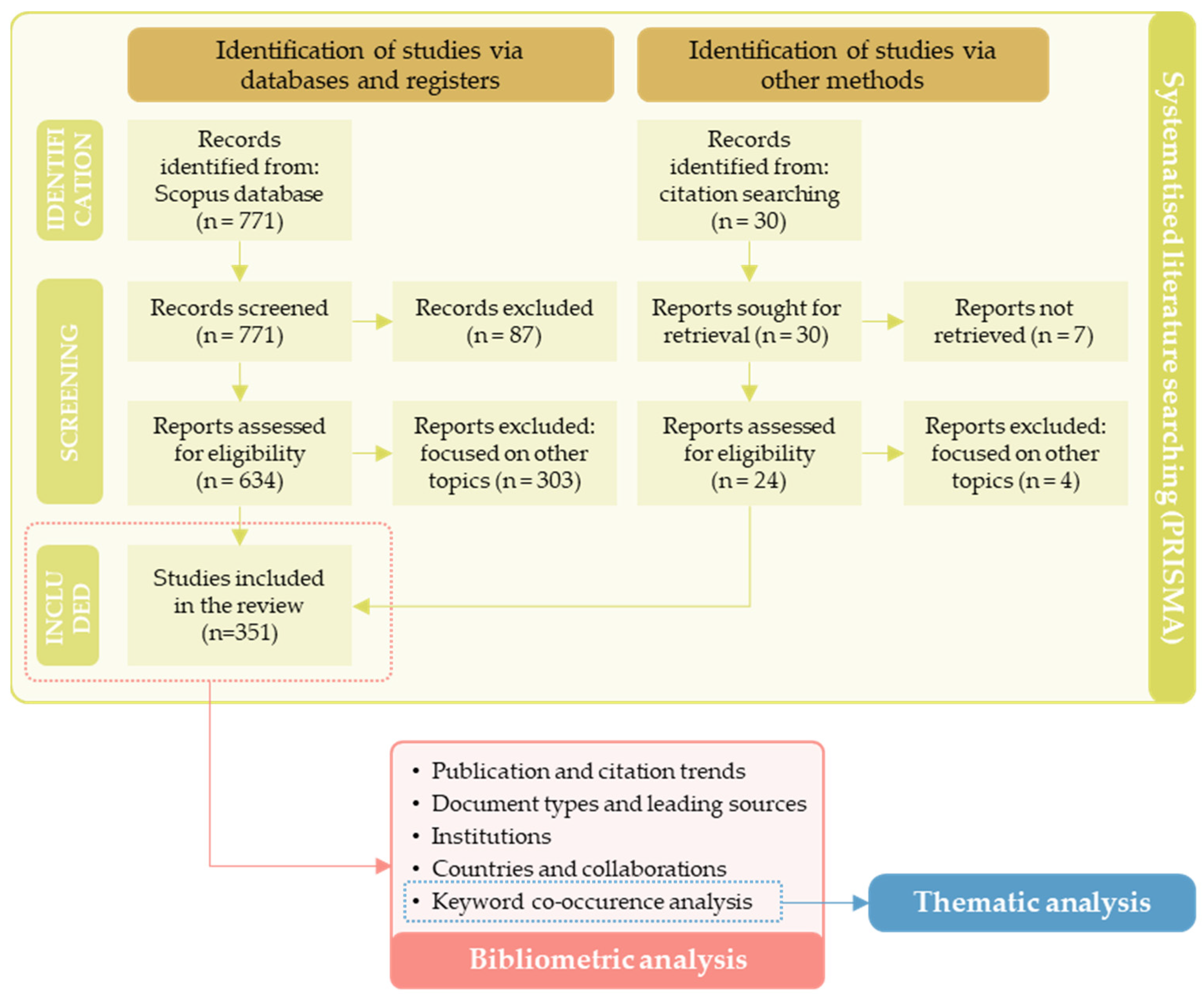
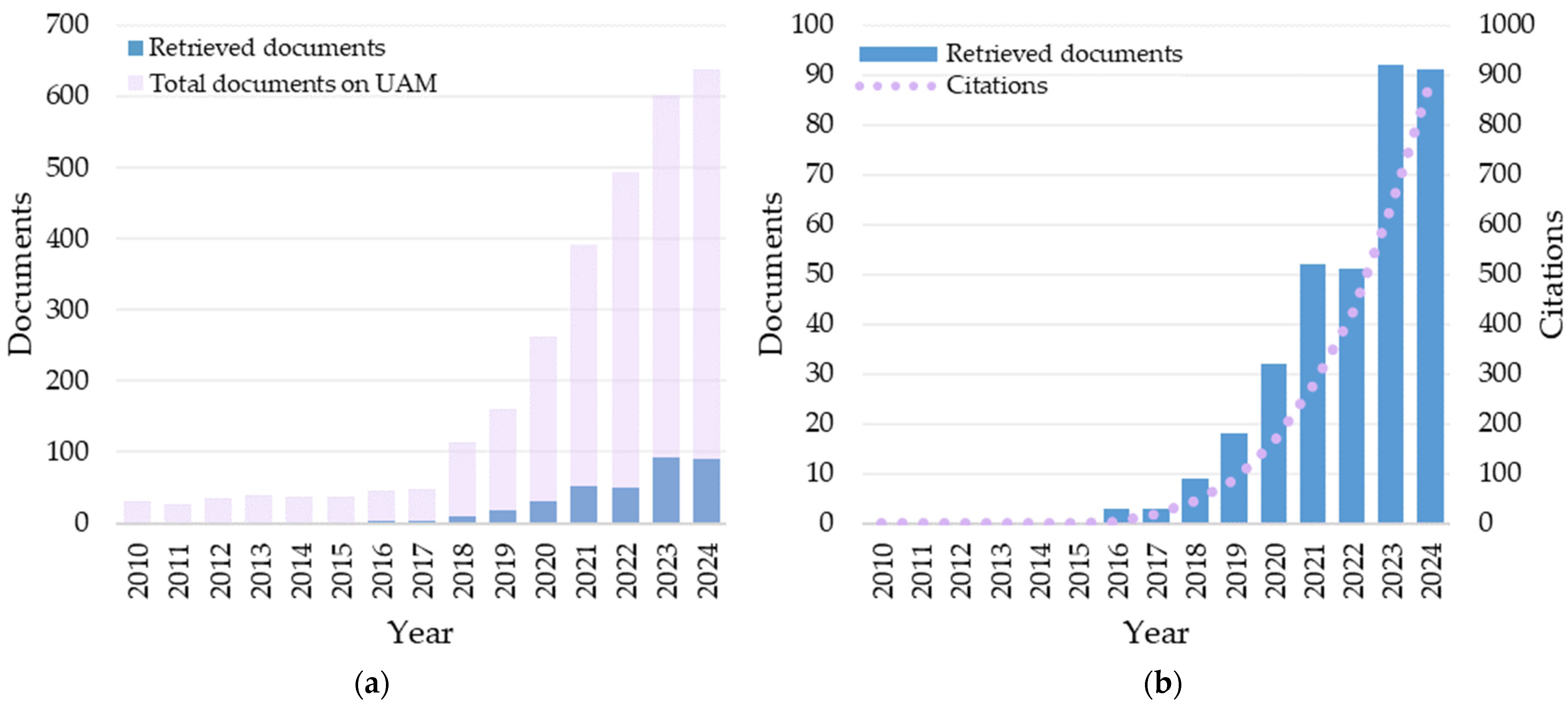
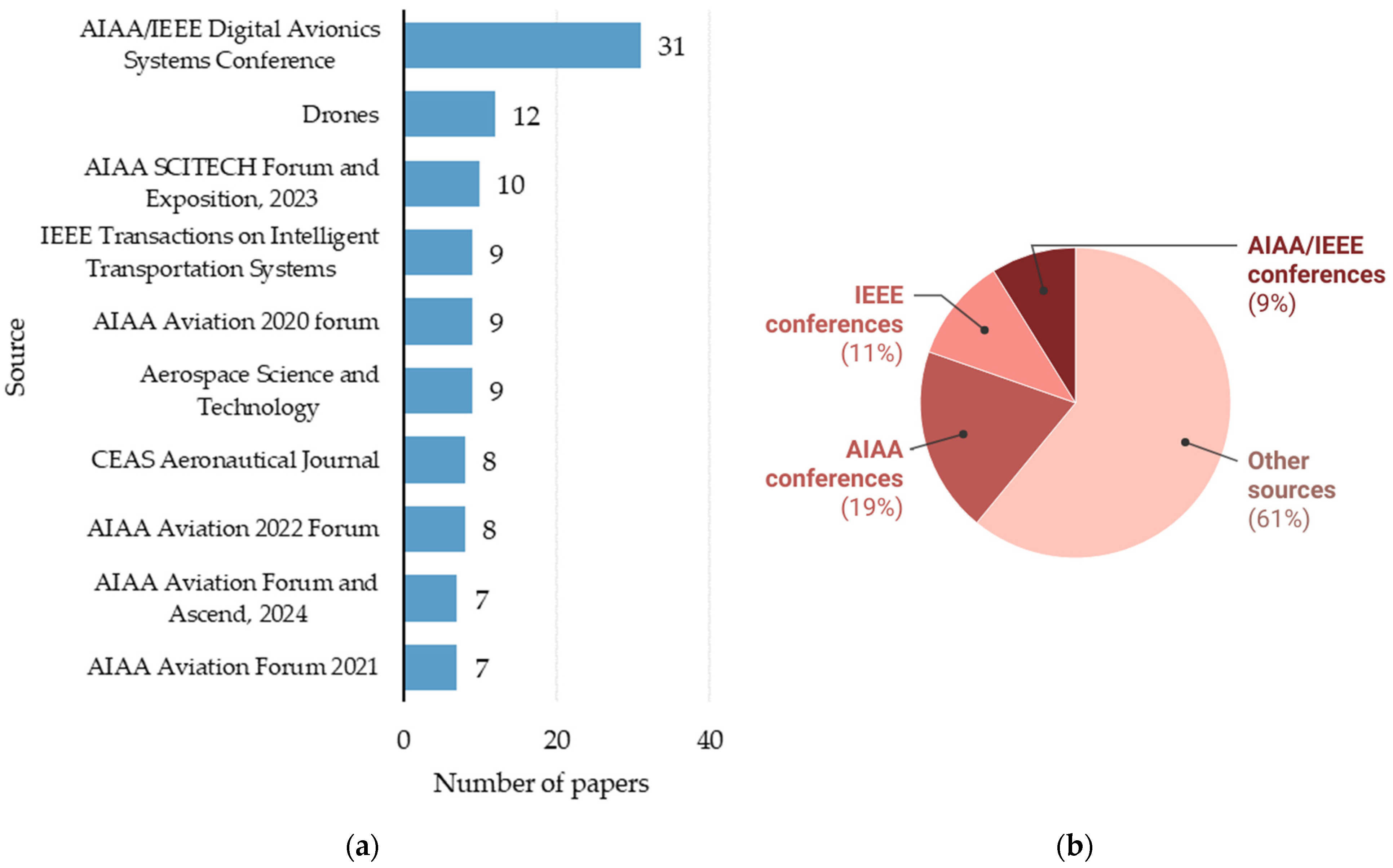
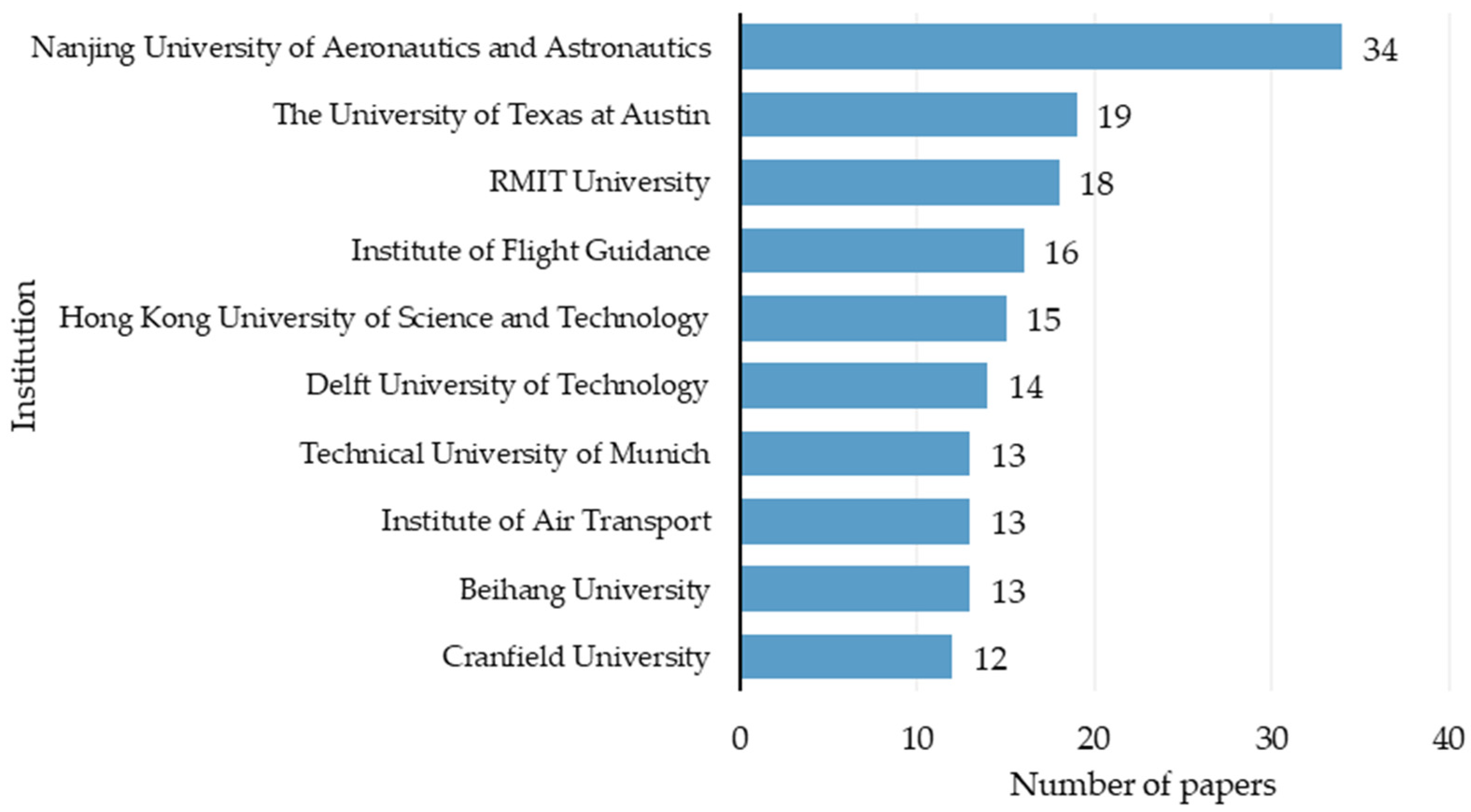
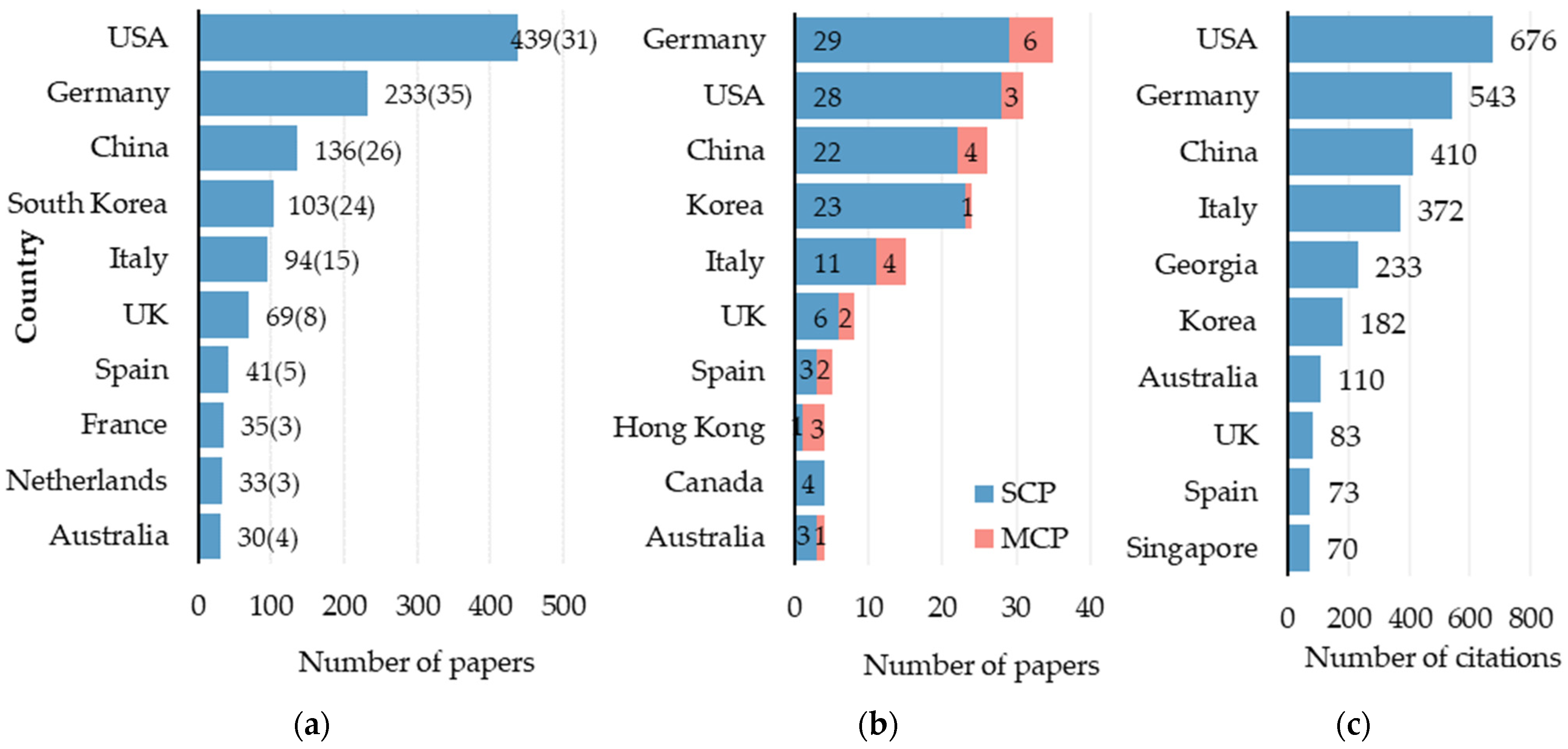
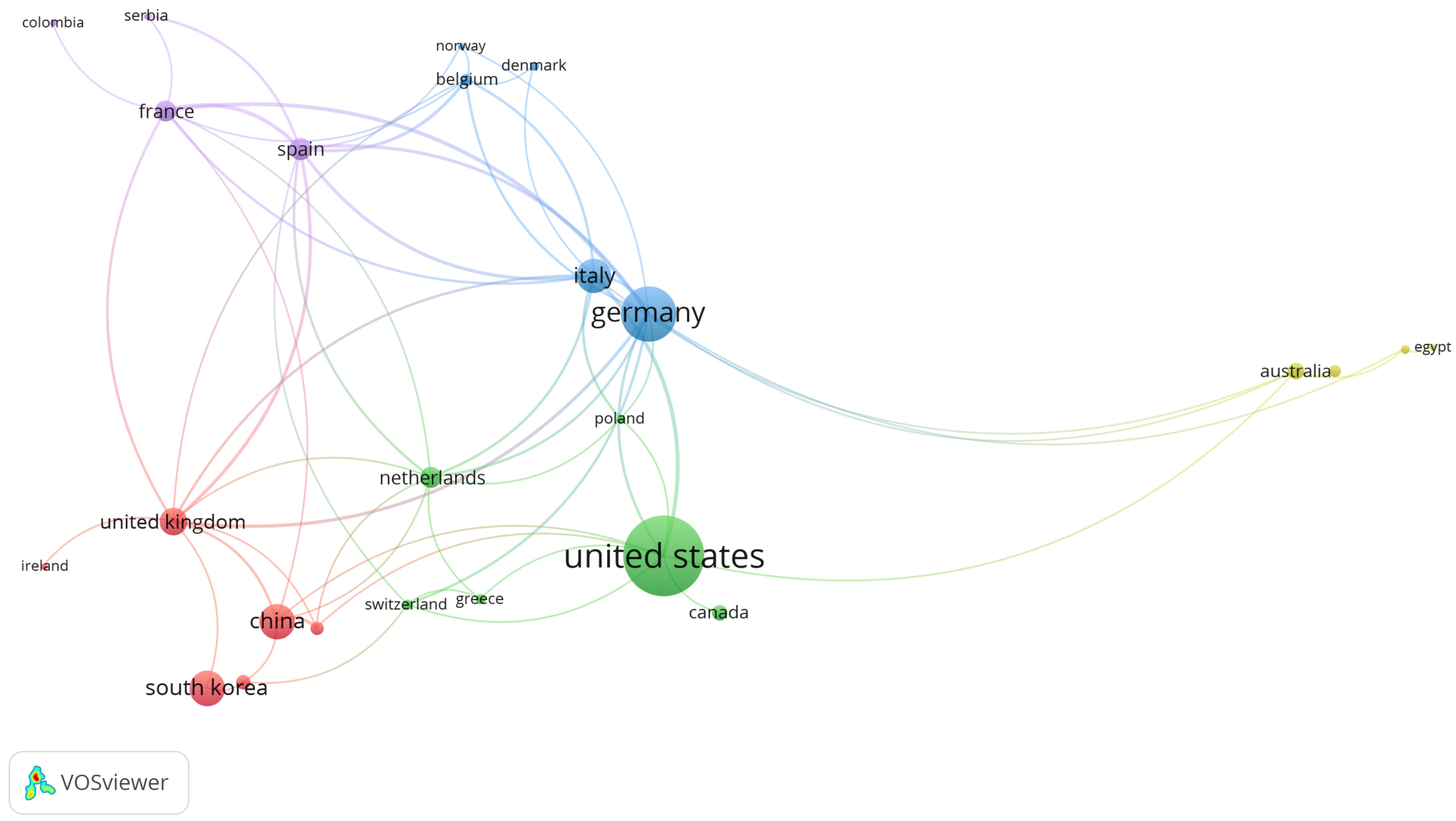
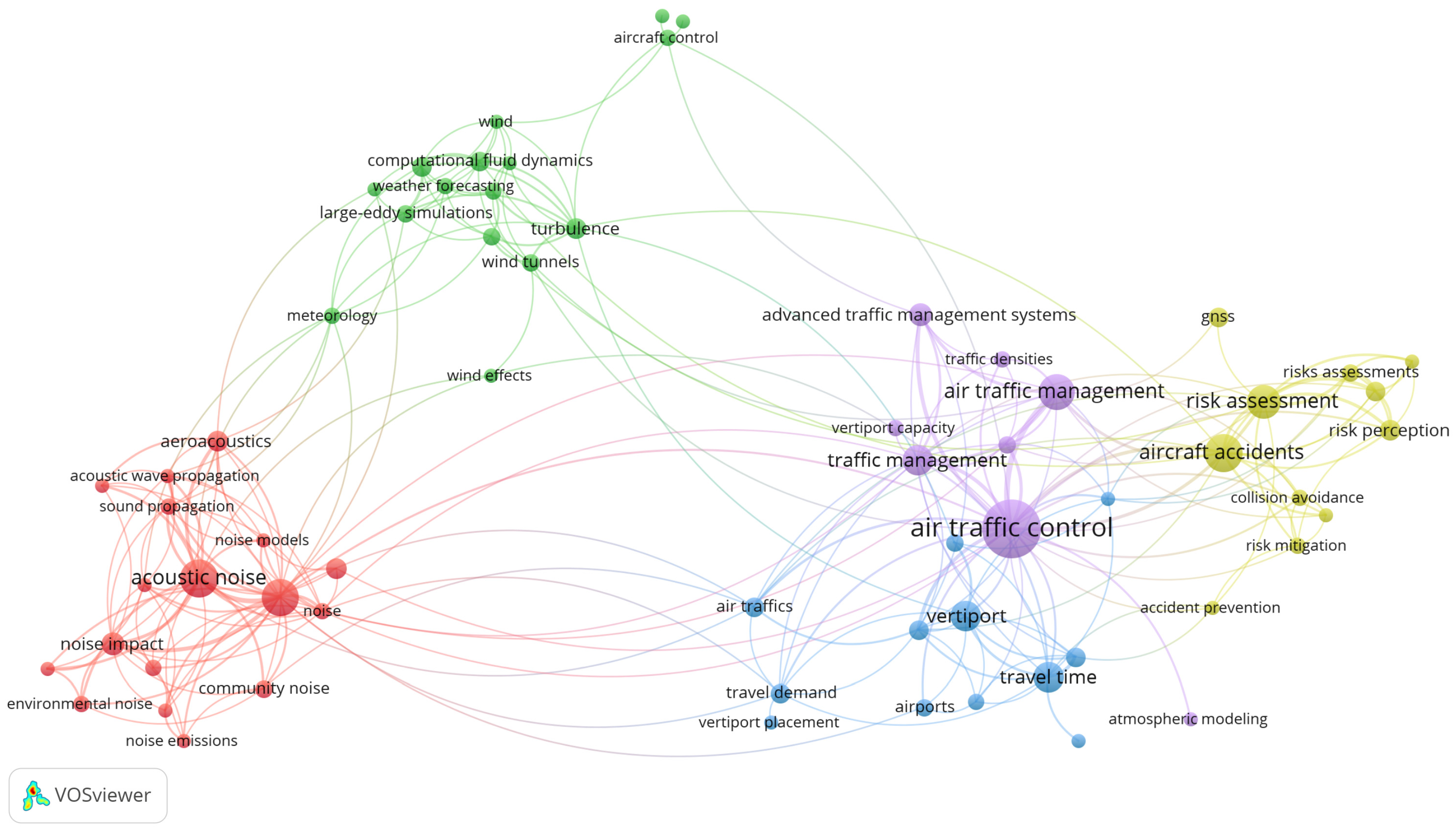
| Year | N. of Publications | Annual Growth Rate |
|---|---|---|
| 2010 | 0 | - |
| 2011 | 0 | - |
| 2012 | 0 | - |
| 2013 | 0 | - |
| 2014 | 0 | - |
| 2015 | 0 | - |
| 2016 | 3 | - |
| 2017 | 3 | 0.0% |
| 2018 | 9 | 200.0% |
| 2019 | 18 | 100.0% |
| 2020 | 32 | 77.8% |
| 2021 | 52 | 62.5% |
| 2022 | 51 | −1.9% |
| 2023 | 92 | 80.4% |
| 2024 | 91 | −1.1% |
| Title | Author, Year | Journal | TC | TC per Year | Normalized TC |
|---|---|---|---|---|---|
| Urban Air Mobility: History, Ecosystem, Market Potential, and Challenges | Cohen et al., 2021 [19] | IEEE Transactions on Intelligent Transportation Systems | 260 | 52.00 | 10.97 |
| An overview of current research and developments in urban air mobility—Setting the scene for UAM introduction | Straubinger et al., 2020 [18] | Journal of Air Transport Management | 287 | 47.83 | 9.90 |
| Urban air mobility: A comprehensive review and comparative analysis with autonomous and electric ground transportation for informing future research | Garrow et al., 2021 [2] | Transportation Research Part C: Emerging Technologies | 233 | 46.60 | 9.83 |
| U-Space Concept of Operations: A Key Enabler for Opening Airspace to Emerging Low-Altitude Operations | Barrado et al., 2020 [44] | Aerospace | 147 | 24.50 | 5.07 |
| Loose and Tight GNSS/INS Integrations: Comparison of Performance Assessed in Real Urban Scenarios | Falco et al., 2017 [45] | Sensors | 196 | 21.78 | 2.19 |
| Ground Risk Map for Unmanned Aircraft in Urban Environments | Primatesta et al., 2020 [46] | Journal of Intelligent & Robotic Systems | 114 | 19.00 | 3.93 |
| A Risk-Aware Path Planning Strategy for UAVs in Urban Environments | Primatesta et al., 2019 [47] | Journal of Intelligent & Robotic Systems | 109 | 15.57 | 3.12 |
| On the understanding of the current status of urban air mobility development and its future prospects: Commuting in a flying vehicle as a new paradigm | Pons-Prats et al., 2022 [32] | Transportation Research Part E: Logistics and Transportation Review | 60 | 15.00 | 5.13 |
| Integrated Network Design and Demand Forecast for On-Demand Urban Air Mobility | Wu and Zhang, 2021 [48] | Engineering | 71 | 14.20 | 2.99 |
| Potential Urban Air Mobility Travel Time Savings: An Exploratory Analysis of Munich, Paris, and San Francisco | Rothfeld et al., 2021 [10] | Sustainability | 70 | 14.00 | 2.95 |
| Description | Results |
|---|---|
| Authors | |
| Authors | 1071 |
| Authors of single-authored docs | 18 |
| Authors collaboration | |
| Single-authored docs | 19 |
| Co-Authors per Doc | 4.03 |
| International co-authorships % | 14.53% |
Disclaimer/Publisher’s Note: The statements, opinions and data contained in all publications are solely those of the individual author(s) and contributor(s) and not of MDPI and/or the editor(s). MDPI and/or the editor(s) disclaim responsibility for any injury to people or property resulting from any ideas, methods, instructions or products referred to in the content. |
© 2025 by the authors. Licensee MDPI, Basel, Switzerland. This article is an open access article distributed under the terms and conditions of the Creative Commons Attribution (CC BY) license (https://creativecommons.org/licenses/by/4.0/).
Share and Cite
Campagna, L.M.; Carlucci, F.; Fiorito, F.; Marinelli, E.R.; Ottomanelli, M.; Marinelli, M. Mapping the Integration of Urban Air Mobility into the Built Environment: A Bibliometric Analysis and a Scoping Review. Drones 2025, 9, 692. https://doi.org/10.3390/drones9100692
Campagna LM, Carlucci F, Fiorito F, Marinelli ER, Ottomanelli M, Marinelli M. Mapping the Integration of Urban Air Mobility into the Built Environment: A Bibliometric Analysis and a Scoping Review. Drones. 2025; 9(10):692. https://doi.org/10.3390/drones9100692
Chicago/Turabian StyleCampagna, Ludovica Maria, Francesco Carlucci, Francesco Fiorito, Erika Rosella Marinelli, Michele Ottomanelli, and Mario Marinelli. 2025. "Mapping the Integration of Urban Air Mobility into the Built Environment: A Bibliometric Analysis and a Scoping Review" Drones 9, no. 10: 692. https://doi.org/10.3390/drones9100692
APA StyleCampagna, L. M., Carlucci, F., Fiorito, F., Marinelli, E. R., Ottomanelli, M., & Marinelli, M. (2025). Mapping the Integration of Urban Air Mobility into the Built Environment: A Bibliometric Analysis and a Scoping Review. Drones, 9(10), 692. https://doi.org/10.3390/drones9100692









